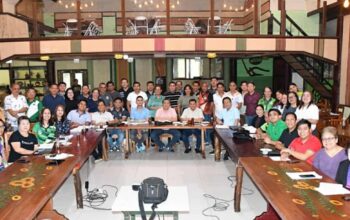
THE water quality, including those in refilling stations, for human consumption in the province is in a sorry state.
Provincial Board Member Lucille Lagunay presented her research of bacteriological quality status of water sources by district during the Capitol Reports on Friday.
“Results of the study show that non-compliance to standards for drinking water continues to undesirably persist throughout the province of Bohol,” she said in her power point presentation before the media.
In first district, water system level III showed that “no record” is high in three-month period. 42% of “no record,” 38% potable and 22% non-potable in August 2022; 38% for no record, 42 potable and 20 non-potable in September; and 47% for no record, 34% potable and 20 non-potable in October.
The district is composed of 13 towns and one city.
In second district of 14 towns, 82% has no record, 18% has potable water and 8% non-potable in August 2022; 71% no record, 24% potable and 5% non-potable in September; and 77% no record, 15 potable and 5% non-potable in October 2022.
In third district of 19 towns with level III system, potable (7%) water is lower than 12% non-potable and 83% has no record in August. Potable (22%) is still lower than 25% non-potable in September; and potable (9%) is still lower than 25% non-potable and 66% no record in October 2022.
“Prolonged inaction on this issue may lead to a rise in enteric (intestinal) illnesses,” Laguay’s report said.
Water bacteriological status in refilling stations may not be similar in the towns, however.
There are 707 in total refilling station in the entire Bohol. First district has 291; second district, 205; and third district, 211, Lagunay said.
Refilling stations’ potable water (65%) is higher than non-potable at7% and 28%, no record in August 2022. In September 2022, potable is at 68%, non-potable,4% and no record, 27%; and 68% potable, 2% non-potable and 28% no record.
In second district, 48% potable, 12% non-potable and 42% no record n August 2022; 60% potable, 9% non-potable and 21% no record in September; and 53% potable, 7% non-potable and 39% no record in October 2022.
In third district, potable water is high, 62% potable, 8% non-potable and 30% no record in August 2022; 74% potable, 12% non-potable and 14% no record in September 2022; and 71% potable, 8% non-potable and 20% no record in October 2022.
“Along with the growing consumerism and tourism boom in the province also comes the proliferation and distribution of unsafe drinking water,” Lagunay said.
She said that more than half of the refilling stations in Bohol rely much of level III water system as their sources.
The study prompted Lagunay to propose a Safe Water Ordinance, which she said, already passed on first reading and it is being referred to an appropriate committee of the provincial board.
The proposed water Ordinance carries penalties to force the concerned local government units and refilling stations to comply with the mandatory submission of water sampling for laboratory test.
“The proposed Ordinance aims to strengthen the compliance of Drinking Water Service Providers in Bohol with related laws and standards on drinking water such as but not limited to the Sanitation Code of the Philippines (P. D. 856) and the Philippine National Standards for Drinking Water,” Lagunay said.
Along with Lagunay in Capitol Reports were Dr. Greg Sodusta, Jeneffer Sordilla of the Provincial Health Office, Engr. Conrado Melisimo, Christine Ranay and Camilo Arano, Jr of Bohol Water Utilities, Incorporated. (rvo)


